
Serradifalco is a town and comune in the province of Caltanissetta, Sicily, Italy.
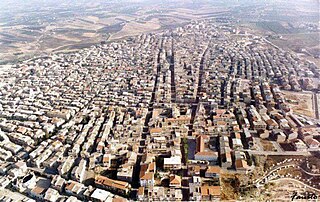
Campobello di Licata is a comune (municipality) in the Province of Agrigento in the Italian region Sicily, located about 110 kilometres (68 mi) southeast of Palermo and about 30 kilometres (19 mi) east of Agrigento.
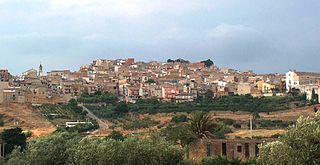
Cianciana is a comune (municipality) in the Province of Agrigento in the Italian region Sicily, located in the middle valley of the Platani river, about 70 kilometres (43 mi) south of Palermo and about 25 kilometres (16 mi) northwest of Agrigento. The Monte Cammarata, elevation 1,579 metres (5,180 ft) above sea level, part of the Monti Sicani chain, is nearby.

San Biagio Platani is a comune (municipality) in the Province of Agrigento in the Italian region Sicily, located about 70 kilometres (43 mi) south of Palermo and about 20 kilometres (12 mi) north of Agrigento. As of 31 December 2004, it had a population of 3,689 and an area of 42.4 square kilometres (16.4 sq mi). San Biagio Platani is famous for its "Easter Arches"
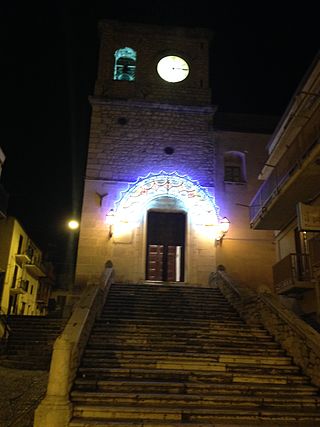
San Giovanni Gemini is a comune (municipality) in the Province of Agrigento in the Italian region Sicily, located about 60 kilometres (37 mi) southeast of Palermo and about 35 kilometres (22 mi) north of Agrigento.

Sant'Angelo Muxaro is a comune (municipality) in the Province of Agrigento in the Italian region of Sicily, located about 70 kilometres (43 mi) south of Palermo and about 20 kilometres (12 mi) north of Agrigento. The town was founded and historically inhabited by the Arbëreshë community.

Santo Stefano Quisquina is a comune (municipality) in the Province of Agrigento in the Italian region Sicily, located about 60 kilometres (37 mi) south of Palermo and about 35 kilometres (22 mi) north of Agrigento.

The Archdiocese of Agrigento is a Latin Church ecclesiastical jurisdiction or archdiocese of the Catholic Church in Sicily, Italy. The historic diocese of Agrigento was also known as the Diocese of Girgenti, and Diocese of Agrigentum. It used to be a suffragan of the Archdiocese of Monreale. A metropolitan see, the Archdiocese of Agrigento has two suffragan dioceses in its ecclesiastical province.
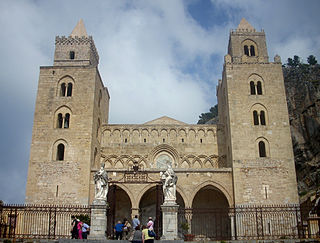
The Diocese of Cefalù is a Latin diocese of the Catholic Church in Sicily, southern Italy. It is a suffragan of the Archdiocese of Palermo.
The Sicilian title Duke of Bivona stems from the middle 16th century. Bivona is in Sicily, which had been conquered by Peter III of Aragon in 1282. It was given to people related to the powerful medieval Aragonese family of Luna, Zaragoza.

Giovanni II Ventimiglia y Moncada, 6th Marquis of Geraci was a Sicilian aristocrat, a member of the prominent House of Venitmiglia.

Fernando de Aragón y Guardato, 1st Duke of Montalto was the eldest bastard son of king Ferdinand I of Naples and Diana Guardato, one of his mistresses.
Peter was the son and heir apparent of Queen Maria and King Martin I of Sicily. He was a member of the House of Barcelona.
Damaso Pio De Bono was the eighth bishop of Caltagirone in Italy.

Lanza are an Italian noble family that originated in Sicily in the 15th century. Derived from a cadet branch of the Lancia family, barons of Longi, it represents one of the major dynasties of the Sicilian aristocracy.

Giacinto Carini was a politician and Italian patriot. He participated in the Sicilian independence revolution of 1848, was a Garibaldian, a general, and a member of Parliament.

The Italian: Chiesa della Madonna Assunta or the Church of the Virgin of the Assumption is a Baroque-style, Roman Catholic church located on Via Maqueda 59-61 in the ancient quarter of Kalsa in central Palermo, region of Sicily, Italy. It rises a block south along via Maqueda from the Palazzo Sant'Elia.
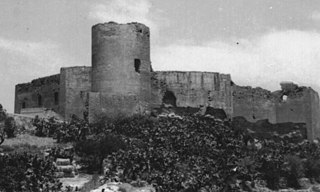
The second case of Sciacca, sometimes also referred to as the third, was the concluding part of the violent conflict fought between Sicily's noble families of de Luna and Perollo between 1455 and 1529, referred to as the "case of Sciacca." The main phases of the conflict were fought in the territories of the feudal town of Bivona and the demesne town of Sciacca, both current Italian municipalities in the province of Agrigento in Sicily, in the summer months of 1529.

The district of Bivona was one of the three districts into which the Italian province of Girgenti in Sicily was divided. Existing from 1860 to 1927, it comprised thirteen municipalities, grouped into five mandamenti, and traced the territory of the eponymous and previous Bourbon district established in 1812 in the Kingdom of Sicily, when feudalism was abolished in Sicily as a result of the new Constitution. It experienced a phase of decline in the 1860s, the years of the post-unification period, followed by a partial regrowth in the following decade; it was abolished in 1927, when the provincial capital was renamed Agrigento.
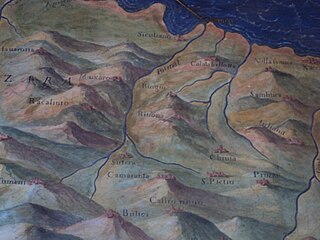
The history of Bivona, an Italian municipality in the province of Agrigento in Sicily, begins with the appearance of the first human settlements in the municipal area dating back to the Copper Age. Also documented in the Bivona area are settlements from the Greek, late Roman and medieval periods. The town of Bivona, although sometimes believed to be of Islamic origin, is documented from 1160: first a simple hamlet, then a lordship, it was one of the main feudal centers of the Vallo di Mazara.



















